The first time I ever cooked Pork Hamonado was in my sister Jehan's tiny apartment kitchen in Bataan. I can still remember her standing beside me, teaching me how to perfectly brown the liempo and whispering her secret touch: letting the vinegar boil untouched to mellow its bite.
"Patience," she'd say with a knowing smile, "that's what makes the pork butter-soft."
Years later, every time I make this sweet-savory dish, the aroma of pineapple and soy sauce simmering together brings me right back to that afternoon.
This family pork hamonado recipe transforms humble pork belly into a melt-in-your-mouth feast that's become my ultimate comfort food and potluck superstar.
If you're craving that perfect balance of matamis-alat flavors that Filipinos love with tender meat that falls apart at the touch of your fork, this recipe is exactly what you need.
Jump to:
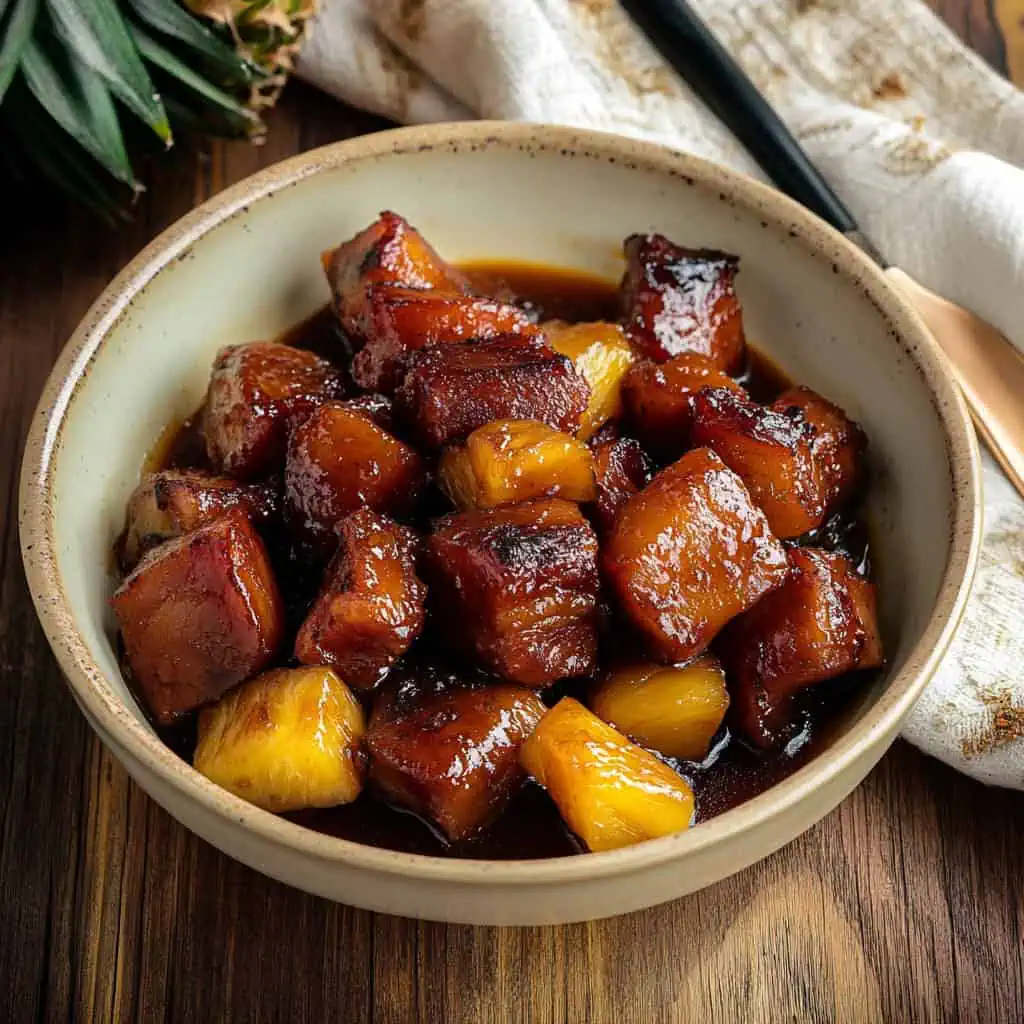
Why You'll Love This Recipe
- Tender, fall-apart pork that melts in your mouth
- Perfect balance of sweet and savory flavors
- Simple ingredients you can find anywhere
- Make-ahead friendly for special occasions
- Impressive dish that's actually easy to make
- Rich sauce that's heaven with steamed rice
Ingredients
This classic Filipino Hamonado combines pork belly, pineapple juice, and soy sauce to create a perfect harmony of flavors and textures. The pork belly provides rich, tender meat with just the right amount of fat that becomes melt-in-your-mouth soft during slow cooking.
Pineapple juice isn't just for sweetness, it contains natural enzymes that help break down tough meat fibers. The soy sauce adds essential umami depth and saltiness to balance the sweetness, while apple cider vinegar brightens the whole dish and helps tenderize the meat further. Brown sugar, onions, and garlic create a caramelized base flavor, while bay leaves and peppercorns add aromatic complexity that ties everything together.
Each ingredient plays a crucial role in creating that signature sweet-savory balance that makes Hamonado a beloved Filipino comfort food.
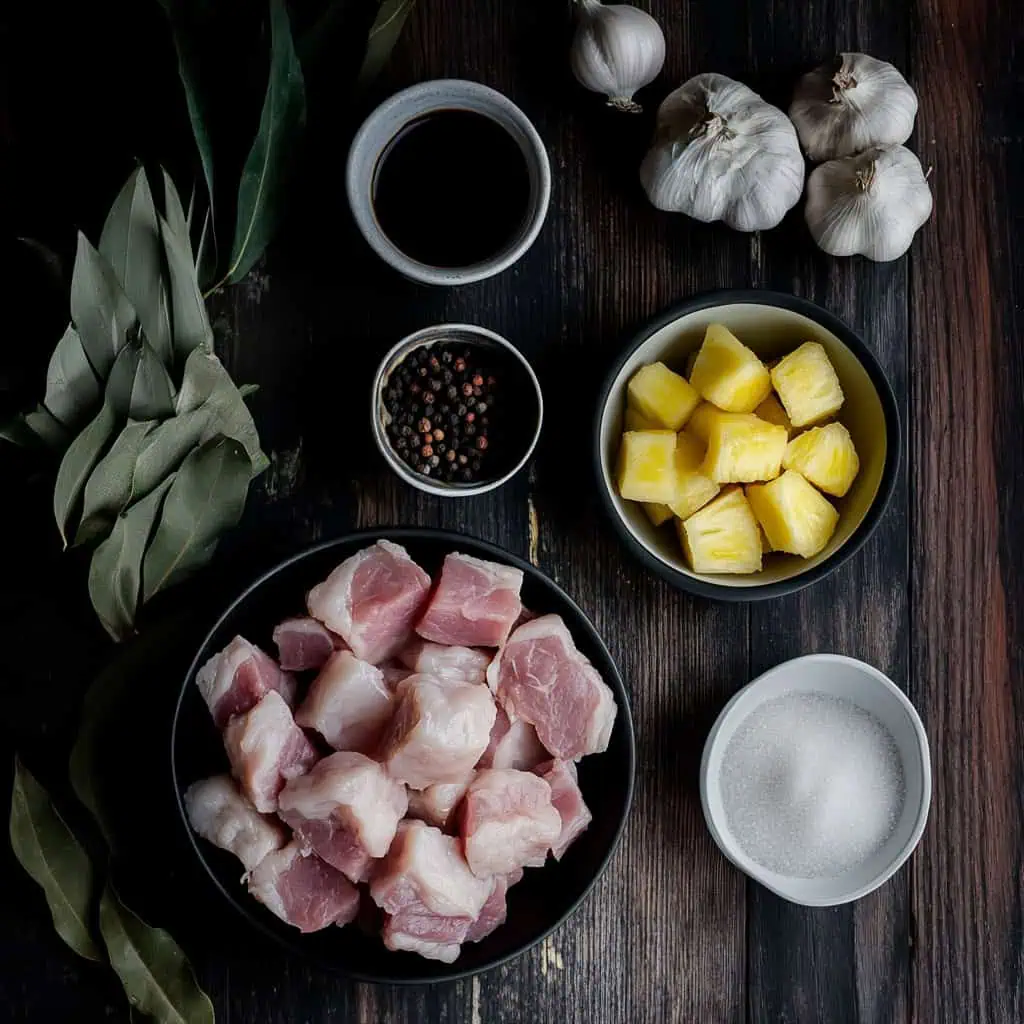
For 6 servings:
- 2 pounds pork belly, cut into 2-inch cubes
- 2 tablespoons canola oil
- 1 large onion, peeled and chopped
- 4 cloves garlic, peeled and minced
- 1 cup pineapple juice from canned pineapples
- ¼ cup apple cider vinegar
- ½ cup soy sauce
- 1 cup water
- 1 teaspoon whole black peppercorns
- 2 bay leaves
- 2 tablespoons brown sugar
- Salt to taste
- 1 cup pineapple chunks
Equipment
- Large heavy-bottomed pan or Dutch oven - Provides even heat distribution and prevents burning
- Sharp knife - For cutting meat into uniform pieces to ensure even cooking
- Wooden spoon - For stirring without scratching the pan's surface
- Measuring cups and spoons - For precise ingredient measurements
- Tongs - For easy meat handling while browning
- Meat thermometer - To ensure proper cooking temperature and food safety
- Paper towels - For patting meat dry before browning
- Cutting board - For safe meat preparation
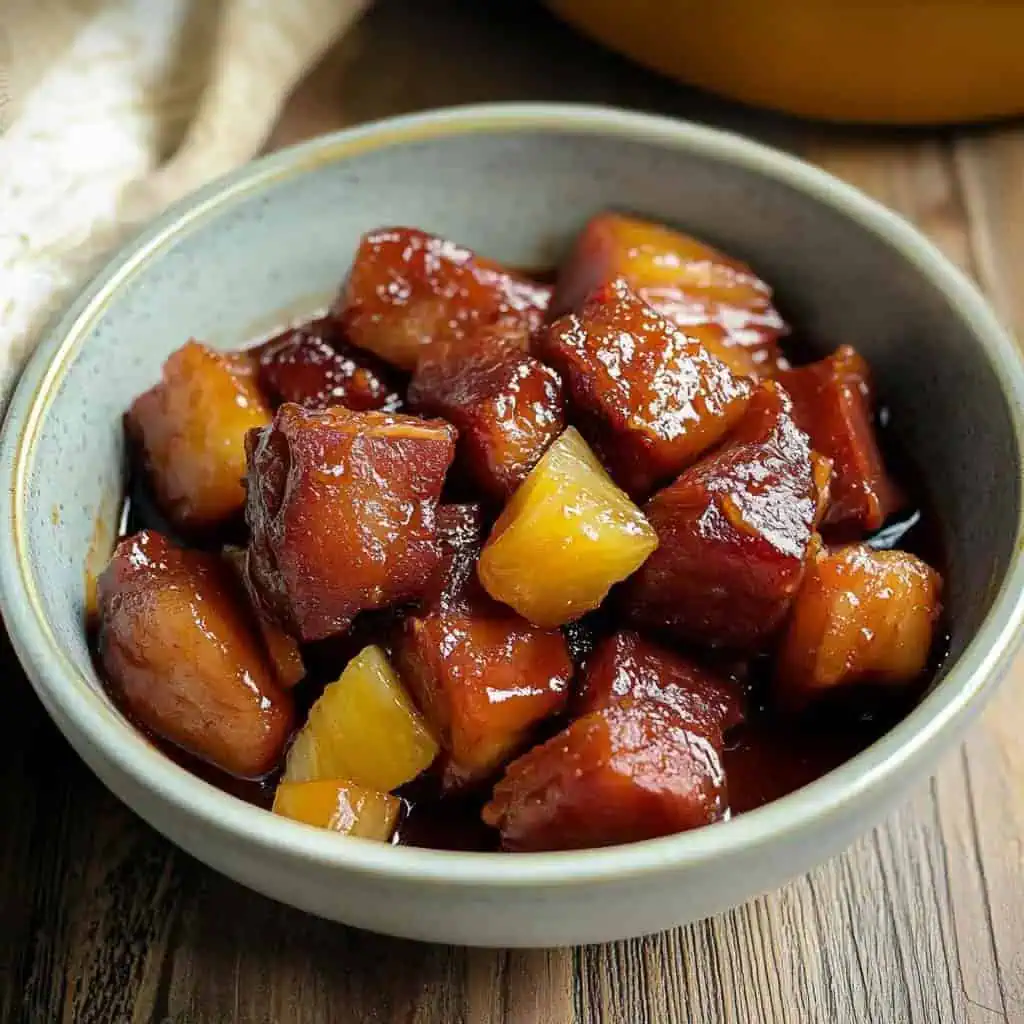
How To Make
- Prepare the ingredients: Pat dry pork belly pieces with paper towels to ensure good browning. Cut into 2-inch cubes and prepare your aromatics by chopping the onion and mincing the garlic.
- Brown the pork: Heat canola oil in a large heavy-bottomed pan over high heat until shimmering. Brown the pork pieces in batches (2-3 minutes per side) until golden brown. Remove and set aside.
- Sauté aromatics: Reduce heat to medium. In the same pan, sauté the chopped onions until translucent, about 3-4 minutes. Add minced garlic and cook until fragrant, about 30 seconds.
- Combine ingredients: Return pork to the pan and add pineapple juice and apple cider vinegar. Let it boil for 2-4 minutes untouched. Add soy sauce, water, whole black peppercorns, and bay leaves.
- Simmer: Reduce heat to low. Cover and simmer for 50-60 minutes or until the pork is tender. Stir occasionally to prevent sticking.
- Finish the dish: Increase heat to medium. Add brown sugar and pineapple chunks. Season with salt to taste. Continue cooking uncovered until the sauce thickens to your desired consistency.
- Serve: Serve hot with steamed rice. Pairs perfectly with pickled papaya (atchara) on the side.

Tips from Lola's Kitchen
- Choose the right cut: Select pork belly with equal layers of fat and meat for the best texture and flavor balance.
- Room temperature meat: Allow meat to come to room temperature before cooking for more even browning.
- The browning step is crucial: Never skip browning the meat as it develops deep flavor compounds that form the foundation of the dish.
- Patience is key: Let the vinegar boil untouched to mellow its acidity and create a more balanced flavor.
- Thickening the sauce: If sauce is too thin, remove meat temporarily and reduce sauce separately at a higher heat.
- Overnight marination: For extra flavor depth, marinate pork overnight in pineapple juice with a splash of soy sauce.
- Skim excess fat: For a cleaner sauce, skim off excess fat that rises to the surface during simmering.
- Rest before serving: Allow the dish to rest for 10 minutes before serving to let flavors settle and meat reabsorb juices.
Substitutions
- Pork cuts: Shoulder, pork butt, or pork loin can replace belly, though cooking times may vary.
- Pineapple juice: Use fresh pineapple juice if available for brighter flavor.
- Soy sauce alternatives: Light soy sauce, tamari, or coconut aminos work well.
- Vinegar options: White vinegar, rice vinegar, or calamansi juice can substitute for apple cider vinegar.
- Sweeteners: Muscovado sugar, palm sugar, honey, or maple syrup can replace brown sugar.
- Aromatics: Shallots can substitute for onions for a milder flavor.
- Liquid options: Chicken broth can replace some or all of the water for added flavor.
- Herbs: Thyme can be used alongside or instead of bay leaves.
Troubleshooting
- Tough meat: If meat isn't tender, continue cooking at a lower temperature for 20-30 minute increments until fork-tender.
- Too sweet: Balance with a splash of vinegar or a squeeze of lemon/calamansi juice.
- Too salty: Add more pineapple juice or a small amount of water to dilute.
- Sauce too thin: Simmer uncovered at slightly higher heat to reduce, or create a slurry with 1 teaspoon cornstarch mixed with 1 tablespoon cold water.
- Sauce too thick: Add small amounts of water, pineapple juice, or broth until desired consistency is reached.
- Greasy sauce: Refrigerate for 30 minutes and skim solidified fat from the top, then reheat.
- Burnt flavor: If bottom starts to burn, transfer contents to a clean pot without scraping the burnt bits.
- Bland flavor: Enhance with a splash more soy sauce, a teaspoon of fish sauce, or additional brown sugar to taste.
Storage & Reheating
- Refrigerator: Store in an airtight container for 3-4 days. Flavors often improve after a day!
- Freezer: Freeze in portion-sized airtight containers for up to 3 months.
- Thawing: Thaw overnight in refrigerator before reheating.
- Stovetop reheating: Warm over low heat with a splash of water to maintain moisture. Stir occasionally until internal temperature reaches 165°F.
- Microwave reheating: Use 70% power in 1-minute intervals, stirring between each interval to distribute heat evenly.
- Oven reheating: Cover with foil and heat at 325°F for 15-20 minutes or until heated through.
- Sauce separation: If sauce separates after refrigeration, gently heat while stirring to recombine.
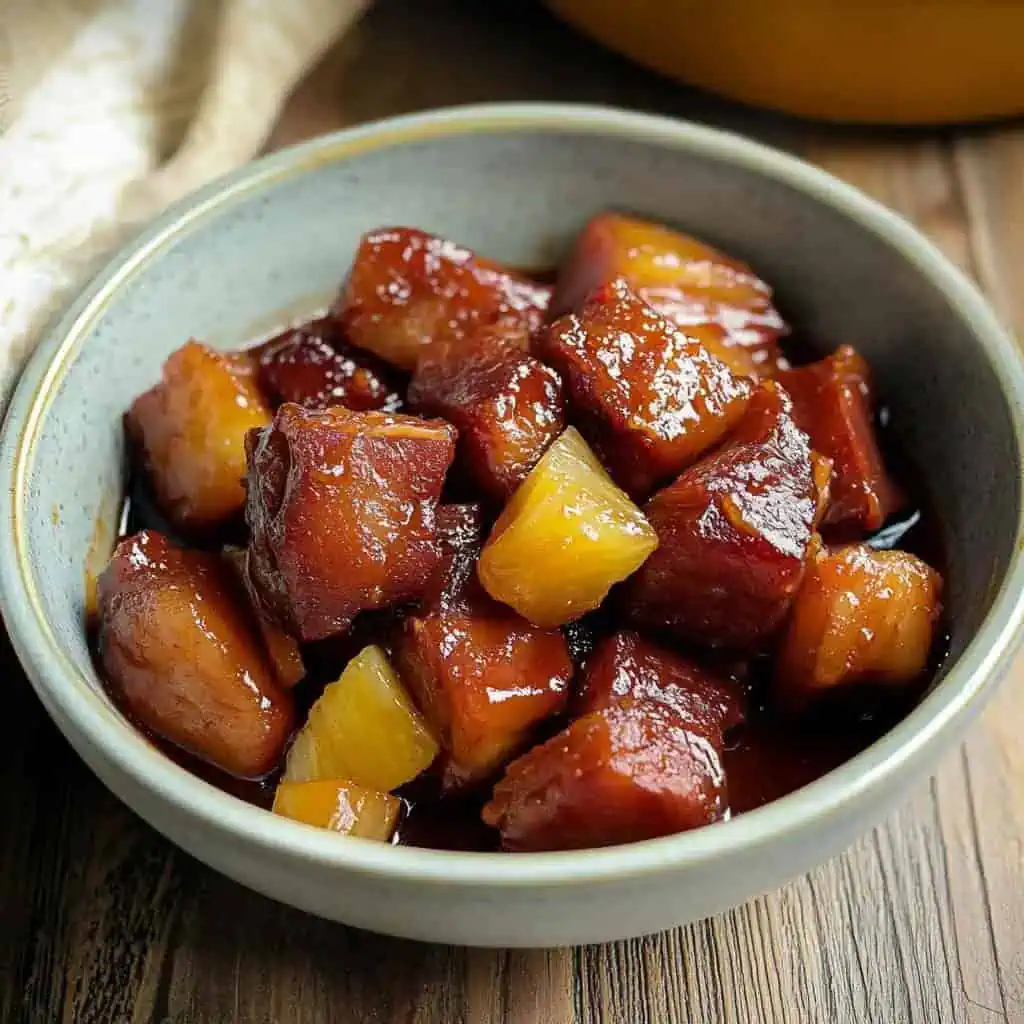
FAQ
Can I make this in a slow cooker?
Yes! Brown the meat first, then cook on low for 6-8 hours or high for 4 hours. Add the pineapple chunks during the last hour.
Why is my pork not tender even after the suggested cooking time?
Different cuts and sizes of meat require different cooking times. Continue simmering until the meat easily yields to a fork. The collagen in pork belly needs time to break down.
Can I use fresh pineapple instead of canned?
Absolutely! Fresh pineapple has natural enzymes that help tenderize the meat. You might need to adjust the sweetness with a little more sugar since fresh pineapple is less sweet than canned.
Is this dish good for meal prep?
Hamonado is perfect for meal prep as the flavors actually improve over 1-2 days. It reheats beautifully and can be portioned with rice for convenient meals.
Can I reduce the sugar for a less sweet version?
Yes, you can adjust the sugar to your taste preference. Start with half the amount and add more if needed. The sweetness balances the saltiness of the soy sauce.
Why do you recommend letting the vinegar boil untouched?
This step allows the harsh acidity to cook off, mellowing the flavor while maintaining the vinegar's tenderizing properties.
Can I add vegetables to make it a complete meal?
Carrots, bell peppers, and potatoes are excellent additions. Add firm vegetables like carrots and potatoes about 30 minutes before the dish is done, and quick-cooking vegetables like bell peppers in the last 10 minutes.
How do I know when the pork is perfectly done?
The meat should easily yield to a fork without falling apart completely. For food safety, internal temperature should reach at least 145°F, but for this dish, cooking to 190°F ensures the collagen breaks down for that melt-in-your-mouth texture.
Related
Looking for other recipes like this? Try these:

Pork Hamonado Recipe (Hamonadong Baboy)
Equipment
- Large heavy-bottomed pan (kaldero) or Dutch oven For even heat distribution and preventing burning
- Sharp knife (kutsilyo) For cutting meat into uniform pieces
- Wooden spoon (sandok na kahoy) For stirring without scratching the pan
- Measuring cups and spoons (Panukat) For precise ingredients
- Tongs [Sipit] For easy meat handling while browning
- Meat thermometer To ensure proper cooking temperature
Ingredients
- 2 pounds pork belly liempo, cut into 2-inch cubes
- 2 tablespoons canola oil
- 1 large onion sibuyas, peeled and chopped
- 4 cloves garlic bawang, peeled and minced
- 1 cup pineapple juice from canned pineapples
- ¼ cup apple cider vinegar suka
- ½ cup soy sauce toyo
- 1 cup water tubig
- 1 teaspoon whole black peppercorns paminta
- 2 bay leaves dahon ng laurel
- 2 tablespoons brown sugar asukal na pula
- Salt asin to taste
- 1 cup pineapple chunks
Instructions
- Begin by patting dry 2 pounds of pork belly pieces (liempo) with paper towels to ensure good browning. Cut into 2-inch cubes and prepare your aromatics by chopping 1 large onion (sibuyas) and mincing 4 cloves of garlic (bawang).
- Heat 2 tablespoons canola oil in a large heavy-bottomed pan over high heat (190°C/375°F) until shimmering. Brown the pork pieces in batches (2-3 minutes per side) until golden brown (hanggang maging golden brown). Remove and set aside.
- Reduce heat to medium (175°C/350°F). In the same pan, sauté the chopped onions until translucent, about 3-4 minutes. Add minced garlic and cook until fragrant (hanggang mabango), about 30 seconds.
- Return pork to the pan and add 1 cup pineapple juice and ¼ cup apple cider vinegar (suka). Let it boil for 2-4 minutes untouched (huwag haluin). Add ½ cup soy sauce (toyo), 1 cup water (tubig), 1 teaspoon whole black peppercorns (paminta), and 2 bay leaves (dahon ng laurel).
- Reduce heat to low (150°C/300°F). Cover and simmer for 50-60 minutes or until the pork is tender (hanggang lumambot ang karne). Stir occasionally to prevent sticking (haluin paminsan-minsan).
- Increase heat to medium (175°C/350°F). Add 2 tablespoons brown sugar (asukal na pula) and 1 cup pineapple chunks. Season with salt (asin) to taste. Continue cooking uncovered until the sauce thickens to your desired consistency (hanggang lumapot ang sarsa).
- Serve hot with steamed rice (kanin). Pairs perfectly with pickled papaya (atchara) on the side.
Tips from Lola's Kitchen
- Choose pork belly with equal layers of fat and meat for the best texture
- Let meat come to room temperature before cooking
- Never skip the browning step - it develops deep flavor
- If sauce is too thin, remove meat and reduce sauce separately
- For extra flavor, marinate pork overnight in pineapple juice
Nutrition
The Story Behind Filipino Pork Hamonado (Hamonadong Baboy)
Pork Hamonado's roots can be traced back to the Spanish colonial era in the Philippines, where it emerged as a creative adaptation of European ham-making techniques. The word "hamonado" itself comes from the Spanish "jamón" (ham), reflecting the Spanish influence on Filipino cuisine during their 333-year colonization of the archipelago.
Unlike traditional European hams that were cured and aged, Filipino cooks ingeniously developed a quicker method using readily available ingredients. They discovered that pineapple juice not only added sweetness but also contained enzymes that helped tenderize the meat. This technique became particularly popular in regions where pineapples grew abundantly, especially in parts of Visayas and Southern Luzon.
The dish gained prominence during fiestas and holiday celebrations, where it became a centerpiece of Filipino family gatherings. Its popularity soared because it offered a practical way to preserve meat in the tropical climate while creating a dish that perfectly matched Filipino tastes - the combination of matamis (sweet) and maalat (salty) that's so beloved in Filipino cooking.
Today, Pork Hamonado has evolved beyond its origins as a preservation method to become a cherished comfort food. Every region has its own variation - some add sprite or 7-up for extra tenderness, others include carrots and potatoes, while some families guard secret ingredients passed down through generations. The dish perfectly exemplifies how Filipino cuisine often transforms foreign influences into something uniquely its own, creating flavors that tell the story of the Philippines' rich culinary heritage.
What makes this dish particularly special is its ability to bring families together. Whether it's served during Noche Buena, Sunday family lunches, or special occasions, Pork Hamonado's presence on the Filipino table represents more than just a meal - it's a celebration of family, tradition, and the enduring creativity of Filipino cooking.
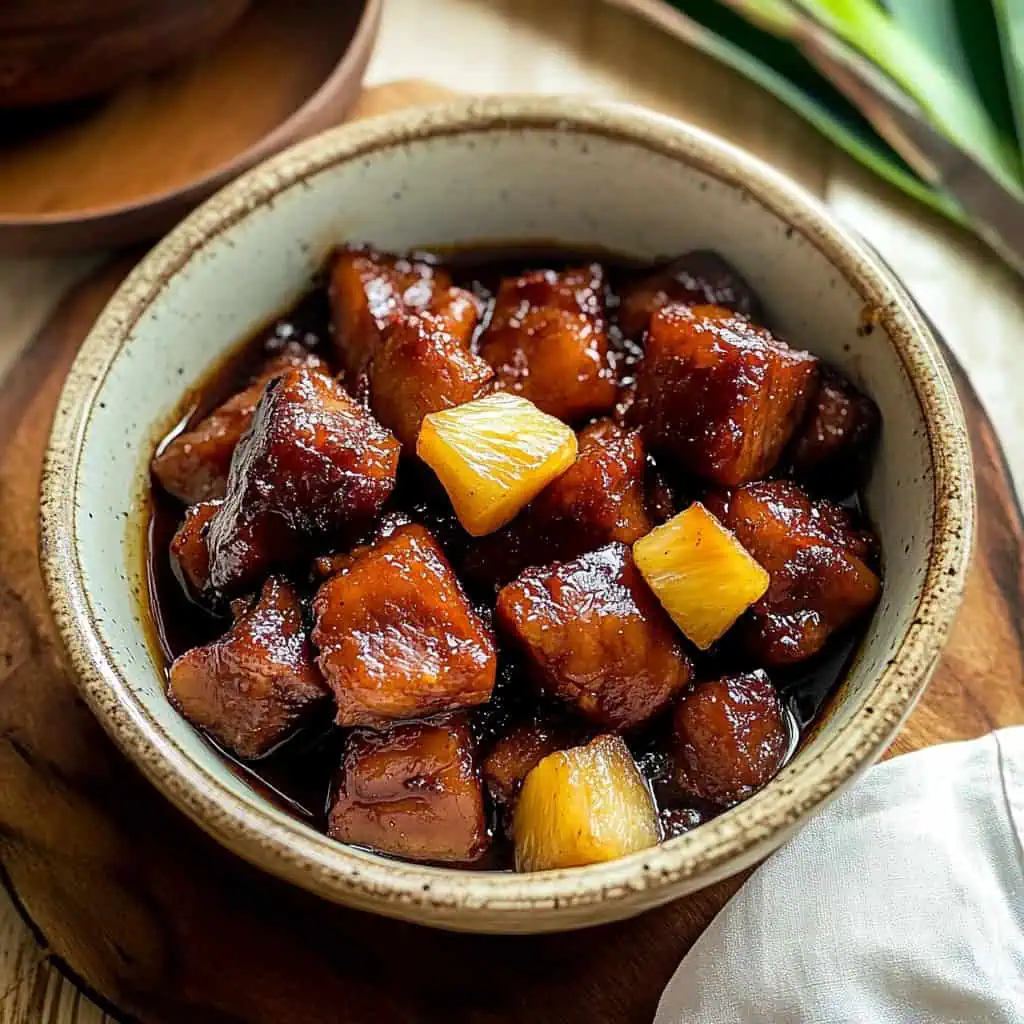









Comments
No Comments